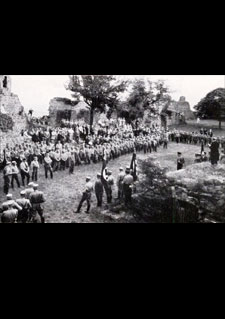Protestantism and Nazism after 1930
Winning 18.3 percent of the votes in the September 1930 Reichstag elections enabled the NSDAP to occupy 107 seats in the Reichstag. The National Socialists had inordinate success in predominantly Protestant electoral districts, especially since Protestant voters were not tied to any denominational party.
Many National Socialists were also active in Protestant organizations. Large numbers of Protestant vicars and theology students had sympathized with the NSDAP from early on. The “movement” was also greeted with much enthusiasm among Protestant youth. Ideological und theological convictions, widespread in the Protestant milieu, facilitated this positive response to the National Socialists .
Nothing affected the National Socialists’ popularity, not even the church governments’ halfhearted resolutions, which attempted to bring the Nazi movement under control in the domain of the church, for instance by forbidding the attendance of SA formations at church services.
Source / title
- In: Oberhessen marschiert. Ein Bildbericht über den Stand der nat.-soz. Bewegung Oberhessens. Gießen 1932, p. 14; © UB Giessen

